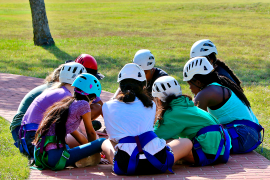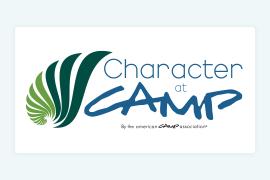We often put a substantial amount of resources into programming for our staff. This coming summer, our staff, if at camp, are unlikely to have as much freedom to go out of camp for their time off and, if at home connecting virtually, are going to want to stay connected throughout the summer. Regardless of whether you are planning staff programs for when staff are at camp or keeping connected with staff virtually, the primary goal for this programming remains the same: have these events be well-attended consistently over time so that staff can bond and feel appreciated. The key here — “consistently” — is what I want to focus on in this post.
How do I provide programming that staff want to come to?
To help unlock some of the potential keys to answering this question, I turn to my field of research in psychology and hone in on the idea of Self-Determination Theory (SDT) — a guidebook for what is commonly known as intrinsic motivation. As the name suggests, SDT is about giving people the power to make their own choices so that their behavior is driven by their own desire. As a quick aside:
- Intrinsic motivation is the natural desire to do something out of one’s own interest. The other side of the same coin is extrinsic motivation.
- Extrinsic motivation is the desire to do something because someone else is motivating you to do so (e.g., with a reward, such as offering food at a program).
While extrinsic motivators are easy to create and are more tangible, intrinsic motivation is the “stickier” motivation that will keep someone doing something for a longer period of time without losing interest (at least not as quickly).
How do I cultivate intrinsic motivation for my staff around staff programming?
The research around SDT provides three drivers of intrinsic motivation and, in turn, consistent staff engagement.
- Autonomy: While autonomy can be summarized as “independence,” a slightly deeper definition is “being responsible for, or in charge of, your own behaviors.” In terms of staff programming, this means giving staff control over the programming. One part of providing autonomy then is to have staff plan the programs and make sure their peers know that someone just like them was in charge of planning it. Another part is to give staff options within the program — it could be several different activities (e.g., improv comedy games, a book-club-style discussion about a popular movie or show, and a how-to-draw instructional lesson) they can choose from or, if you’re online, various breakout rooms they can go into for different conversations or activities.
- Competency: The idea of competency is centered around the ability to do something successfully. In other words, feeling a sense of accomplishment. In terms of staff programming, this can come in a couple of different forms. One form is that whatever activity is happening during staff programming involves a task or goal that staff complete.* Another form is to recognize, or highlight, competence by allowing staff to share a goal they accomplished during the program or a goal that they’ve worked on since the last staff program and have made incremental progress toward reaching or fully accomplished. Think about how you can allow staff to set goals for the activities taking place during the programming and goals for what they are working on outside of the programming time. I always make sure to let staff set their own goals using the SMART framework, which emphasizes Specific, Measurable, Achievable, Result-oriented, Time-constrained goals.
*While having competitive programs (games, etc.) is a fun way to engage staff and make some (i.e., the winners) feel like they successfully accomplished a goal, think about if there are ways to make sure everyone — or at least not only the winners — has a chance to achieve some level of success during programs. This is not to say that everyone needs to get a “participation ribbon,” but rather that during the competition, there may be incremental goals that staff achieve before there is a winner/winning team declared.
- Relatedness. Feeling like you belong as a member of a group, like you are part of something bigger than yourself, is a third driver of intrinsic motivation. This may be the most naturally integrated of the three when it comes to staff programming. You should, however, be sure to articulate and remind staff what it means to be part of the staff community and the value they bring to that community. Also, it’s important to not create a strong sense “me” and “them.” In terms of staff programming, one example may be the difference between having a competitive activity (e.g., trivia or color-war style competition) versus having a collaborative activity (e.g., everybody working to solve the same puzzle or challenge with each staff member, or each group of staff members, coming up with parts of a full solution or idea), or at least providing one of each during a staff program. While being competitive is fun, that fun can wear off more quickly than the sense of relatedness — not to mention competence — that comes from working all together.
I know this summer will be different in many ways, regardless of your camp’s path forward. One thing that won’t change, though, is the need to keep our staff consistently engaged so they bond and feel appreciated. Using the framework provided here can help to ensure the engagement sticks.
This blog was written as part of Project Real Job’s initiative to support camps with staff recruiting, hiring, and retention efforts.
Daniel Shore is a researcher and consultant with PhD in workplace psychology. He conducts research across numerous settings, from cybersecurity teams to summer camps, and turns data into action by (1) facilitating training experiences, (2) conducting feedback focus groups, and (3) creating professional development and training curricula. In the camp world, Daniel combines his ten summers of experience as a staff member, unit supervisor, and director of staff and leadership development with his research expertise to help camps strategically train staff to enhance the camp staff experience. Daniel is looking to work with camp leaders who believe what he believes: to have a great camp with happy campers, you need happy counselors. Feel free to email Daniel with any thoughts, questions, or interest in being a partner through research and training workshops at Daniel@IMShore.com.
Photo courtesy of Oso Lake Scout Camp in Santa Margarita, California




